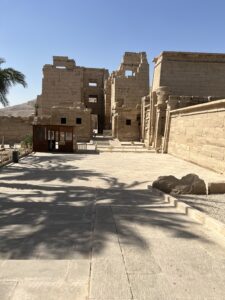Habu temple
It features the impressive mortuary temple of Ramses III and also encloses a well-preserved pharaonic palace. The site is unique because it is one of the few where you can find the resting house of a king, giving insights into their daily life. The site was a complex of temples dating from the beginning of the New Kingdom (1569 BC). A temple to Amun was built here by Hatshepsut and Thutmose III. Then, Ramesses III also chose this site as the location of his mortuary temple and commissioned a massive mud-brick enclosure around the entire site; within this were included storehouses, workshops, administrative offices, and residences of priests and officials. The walls sheltered the entire population of Thebes during the foreign invasions of the 21st Dynasty (1081–711) and for three centuries afterward, they protected the Coptic population. The temple precinct is about 214 meters (700 feet) by 305 meters (1,000 feet). The reliefs at the front of the temple depict Ramses III as a victor in several wars. Attached to the temple is one of the few king’s houses remaining. The throne room and other spaces are well preserved. You will also see the remains of an early Christian basilica and a small sacred lake.
The history of Medinet Habu
Medinet Habu (Habu’s Town) is the Arabic name for the gigantic Mortuary Temple of Ramses III, a structure second only to Karnak in size and complexity and better preserved in its entirety. It is also the only site in Egypt that has a well-preserved Pharaonic palace within its enclosure.
Medinet Habu was both a complex of temples dating from the beginning of the New Kingdom (1569 BC) beforeRamses III enclosed both structures within a massive mud-brick enclosure that included storehouses, workshops, administrative offices, and residences of priests and officials.
The complex’s massive enclosure walls sheltered the entire population of Thebes during the Libyan invasions of the 21st Dynasty (1081-711 BC) and for three centuries afterward it protected the Coptic population.
The main attraction is the great memorial temple of Ramses III; it was a focus for the pharaoh’s cult, linking him to Amun-United-with-Eternity.
The temple precinct measures about 214 m (700 ft.) by 305m (1000 ft.). It contains more than 22,350 m2 (75,350 sq ft) of decorated surfaces across its walls.
You enter the site through the unique Syrian Gate, The Migdol Gate, which is named after the Syrian fortress that so impressed Ramses with its lofty gatehouse that he built one for his own temple.
The front of the temple represented Ramses III in its relief as the victor in several wars. The most famous are the fine relief of his victory over the sea peoples and Libyans.
Around the funerary temple, you will see the remains of an early Christian basilica as well as a small sacred lake.
Some of the best reliefs are on the outer walls of the temple, the famous battle reliefs of Ramses II run along the temple’s northern wall, and they are in chronological order, as Ramses III intended them to be seen.
Attached to the temple is one of the few King’s Houses that is still standing. The throne room and other spaces are well preserved, and visiting in the afternoon is the best time to see the detail of the colours and designs.
The colour of many of its bas-reliefs is still intact, like the religious festivals and on the treasure chambers whose reliefs show the weighing of myrrh, gold, and lapis lazuli.

